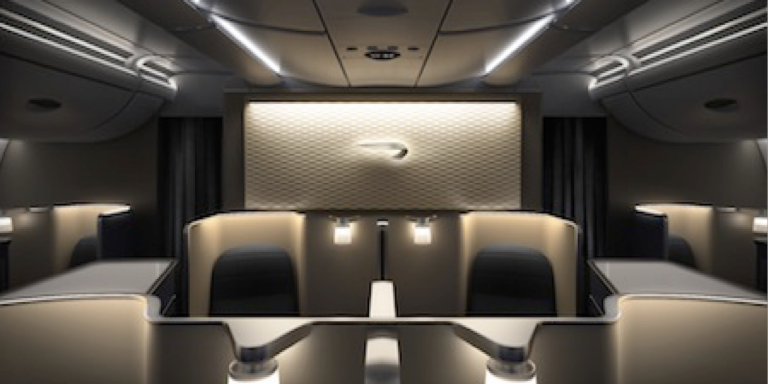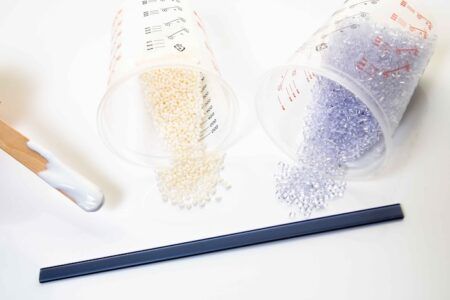Typical. You wait 17 years for BA to get a new long-haul aircraft model, and two come along at once. It’s worth the wait, though, when the aircraft are an A380 and a B787-8. “This is the big one,” said BA CEO Keith Williams at the launch as he stepped out of the first of the airline’s 12 flagship A380s. “This is a momentous moment for the airline. In 17 years we haven’t had any new long-haul aircraft, so to get two in a week is not what we anticipated at the time [of ordering], but we’re delighted to have them. They are the future of the airline.”
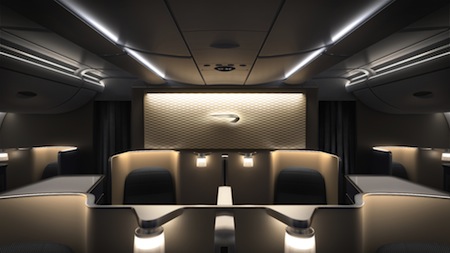
The new aircraft form part of a £5bn investment into improving the BA passenger experience, both in the air and on the ground, but one must remember that the design work on these aircraft began in 2008, in the midst of a recession. Thus the new interiors show some British reserve, being a refinement of the latest product on the refurbished B777-300ER fleet rather than all-new designs, especially since specifying new product wouldn’t have fit with the development cycle.
As Frank van der Post, BA’s managing director of brand and customer experience, says, “A lot of investment has gone into the customer experience. It’s a major investment into the future of BA. We wanted to give people the comfort of the surroundings they know and appreciate, but we wanted to evolve the design.”
Richard Stevens, BA’s new creative director, adds that the idea was to wipe the slate clean and offer a better quality of product at a detail level, improved across all cabins. Stevens is well placed in his role because he has years of experience in designing BA product in his other role as founder of the Forpeople design agency, based in London.
First class
Enter Door 1 on the A380 and a spacious entryway greets you with some wonderful options: left into the cockpit, upstairs to Club World, or right into first class and beyond. Let’s turn right…
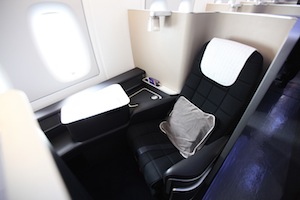 Overall the cabin feels familiar, with the same colours, materials and finishes as found on the latest B777-300s. Sadly one feature found on the triple sevens and B747s isn’t present on the A380: the bespoke sidewalls with glass-effect windows, complete with blinds and ambient lighting controlled from the seat.
Overall the cabin feels familiar, with the same colours, materials and finishes as found on the latest B777-300s. Sadly one feature found on the triple sevens and B747s isn’t present on the A380: the bespoke sidewalls with glass-effect windows, complete with blinds and ambient lighting controlled from the seat.
This omission was a disappointment to Stevens: “Those sidewalls change the feel of the first class cabin, but they aren’t in the A380. There’s work to be done to try and bring a consistency of experience for the customer on both Boeing and Airbus products. You can’t just put the same products on an Airbus and a Boeing, but if we do something right and we find something customers like, we need to find a way to incorporate it on both. So on the A380, while the first class CMF is the same as on other aircraft, the cabin feel is different because it doesn’t have the bespoke sidewalls.”
The 14 seats are the same super first class product from B/E Aerospace as launched in 2011 and found in the B777-300s. However, in keeping with those aims of enhancing the product and its space, the suites are now configured more in-line, and have a larger footprint, which allows for some 30% more personal space, as well as 60% more stowage space in and around the suite, including a seat-side stowage box containing power and USB sockets and the IFE handset, and a wardrobe that is large enough to accommodate a bag, sleep items such as duvets and pillows, and to hang a coat. These stowage features meant that no central overhead stowage lockers were required in the cabin, although the changes did mean that the seat needed to be recertified.
Much of the first class development work lies under the surface, as BA put a lot of effort into improving the robustness and durability of the products in service through subtle enhancements and investments in better materials. For example, in this latest seat, all the metal parts are now anodised, with exactly the same finish as many Apple products, so they don’t suffer from the chips and scratches that plated or painted parts can, improving customers’ perception of quality and reducing maintenance requirements.
“Those are the kinds of areas where we’ve invested a lot of time and effort in the new aircraft,” says Stevens. “It was really about maximising the potential of that seat in the A380 cabin. It was an opportunity to take the learnings from the product and improve on it.”
The B787-8 does not have a first class cabin, but a BA source has stated that one is currently being designed for the B787-10s, and potentially the B787-9s, which will be arriving from 2015.
Club World
One thing BA definitely got right with the B747 configurations was the splitting of business class into cabins over two floors. Frequent flyers have their favourite spots on both decks, and those flying on the A380 can still enjoy their favoured locations, with the 97 seats split into a 44-seat cabin on the main deck and a 53-seat cabin on the upper deck.
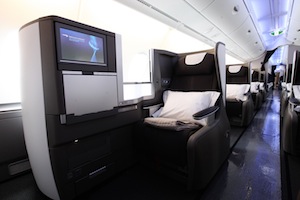 The main deck cabin features the famous and distinctive bespoke yin-yang seats from B/E Aerospace, configured 2-4-2. However, there has been more extensive CMF work than in first class, to match the treatments on the A318s that travel on the all-business London City to New York JFK route, such as the herringbone seat fabric and the darker seat shell finish, which is designed to better react to light than the previous generation. This CMF does not feature on the B777-300ERs.
The main deck cabin features the famous and distinctive bespoke yin-yang seats from B/E Aerospace, configured 2-4-2. However, there has been more extensive CMF work than in first class, to match the treatments on the A318s that travel on the all-business London City to New York JFK route, such as the herringbone seat fabric and the darker seat shell finish, which is designed to better react to light than the previous generation. This CMF does not feature on the B777-300ERs.
There have also been some refinements to the product, with the footstools redesigned to be simpler and more intuitive to use, with better functionality, and revised positioning of seat controls.
Of particular note is the controls for the shields. The yin-yang configuration puts you face to face with your neighbour, which creates problems for delicate British etiquette in deciding when to raise the barrier and break contact – made worse by the location of the shield button at the top of the divider, which is good for crew access, but makes the process more awkward for the passenger. Now there is a second button below the shield, within easy reach when sitting, which eases the moment of snubbing your neighbour.
“It’s a general enhancement. The seat is almost exactly the same as before, but with detail improvements. The programme was about iterative developments and improvements,” says Stevens, adding that, “The work the guys at Tangerine [the industrial designers who have been involved with the yin-yang configuration from the start] did on the seat geometry and optimised comfort of the seat positions is brilliant – the best in the industry. Other airlines may have wider or longer beds, but the seated comfort is very good, and you don’t see many people adjusting themselves to get comfy.”

However, those flying business on the A380 upper deck, or in the 35-seat B787 cabin, will notice a major new development of the seat: a new 2-3-2 configuration, created simply because the familiar 2-4-2 layout wouldn’t fit in these spaces. These middle seats are better for lone travellers, because they don’t have the ‘double bed’ feel of the 2-4-2 version.
As Stevens says of the configuration, “While there’s a loss in seat density, there’s an improvement in terms of proposition. The middle seat is also wider, so what you lose by not being next to a window or aisle, you gain with a little extra space and privacy.”
Those in the middle also gain a small extra surface for stowing small items. Sitting in this seat with both shields up, you do feel rather cut off from the rest of the cabin, but for those seeking privacy, the middle seat is now desirable.
Club World passengers entering Door 1 on the B787 don’t get the same sense of occasion as they do upon boarding the A380, as revenue models did not allow for a dramatic entry space or social area. However, the galley area they enter through can be accessed during flight when a portion becomes the Club Kitchen in the galley area, to enjoy a snack or have a chat without disturbing sleeping passengers. A380 passengers can also enjoy this facility – but no bar.
Premium economy
Seasoned BA B777-300 flyers will recognise the World Traveller Plus seats, a Recaro product customised for BA, finished in the B777 CMF specification. The seatback is a unique design, driven mostly by the need to accommodate the widescreen IFE display. The USB controls are also incorporated on the backshell as they would be awkward to access on the centre console within the 38in pitch.
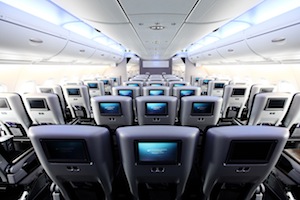 It’s a good premium economy offer, and a major step up from the ageing seats found on the B747s. As Stevens says, “We designers get frustrated when we’re told we have to make do and enhance an existing off-the-shelf platform, but I flew it recently from Tokyo and it’s a pretty good product.”
It’s a good premium economy offer, and a major step up from the ageing seats found on the B747s. As Stevens says, “We designers get frustrated when we’re told we have to make do and enhance an existing off-the-shelf platform, but I flew it recently from Tokyo and it’s a pretty good product.”
On the A380, premium economy is split into a 44-seat cabin on the main deck and 53 on the upper deck. Of the two options, the upper deck is the better choice as, although it is a little less intimate, the window seats benefit from side stowage areas that also increase personal space.
On the B787, premium economy passengers will be pleasantly surprised to find that, after passing through the 35-seat business cabin, their cabin is a little more intimate, at a mere 25 seats.
Economy
 Economy passengers also get the same Recaro seats found on the B777s, with a 31in pitch, but while it’s the most off-the-shelf product on board, Stevens is still proud of the standard of comfort.
Economy passengers also get the same Recaro seats found on the B777s, with a 31in pitch, but while it’s the most off-the-shelf product on board, Stevens is still proud of the standard of comfort.
“In both economy and premium economy, we did a lot of work on improving seat cover comfort systems. So while the cushion technology is standard on these platform seats, the dress covers have been designed to try and enhance comfort levels. One of the big things for me as part of Forpeople is that we do a lot of work with Herman Miller [makers of the famous Aeron ergonomic office chairs], so we’re gaining knowledge in true seat comfort and how you enhance that, and a lot of that knowledge can be fed into aircraft seats.
“A lot of airline seat designers only have experience of designing seats for aircraft, and a lot of the suppliers that deliver the seats are companies that deliver engines and mechanisms which happen to have a seat on them and transform from seat to bed, but they’re not leaders in seat comfort and there needs to be a change.”
Big ideas, small spaces
The sheer capacity of the A380 could lead to soulless economy cabins if configured insensitively. BA has long been praised for its breakup of cabin spaces though, especially the premium spaces on its B747s, and this work shows on the new aircraft.
 On the A380, the 303 economy seats are split into 199 on the main deck and 104 on the upper deck. In turn, economy on both decks is split into two cabins, with the rearward cabin on the upper deck configured with a mere 36 seats. This is a remarkable space for an economy flyer, and would serve perfectly as a testbed for new ideas, much like the rear upper deck on Malaysia’s A380, where innovations such as child-free areas can be trialled.
On the A380, the 303 economy seats are split into 199 on the main deck and 104 on the upper deck. In turn, economy on both decks is split into two cabins, with the rearward cabin on the upper deck configured with a mere 36 seats. This is a remarkable space for an economy flyer, and would serve perfectly as a testbed for new ideas, much like the rear upper deck on Malaysia’s A380, where innovations such as child-free areas can be trialled.
BA’s van der Post states, “I think the way we split the cabins on the upper and lower deck with smaller cabins gives it a very intimate feel. If you look at the customer feedback from the B747 upper deck, people really like it because it has almost a private jet feel, and that’s what we tried to create in the A380 experience. The A380 is a much bigger aircraft so it’s a little harder to get that feel, but you won’t find massive spaces with hundreds of people – it’s all carved up a little and I think that’s going to be the big win.”
On the B787, this feel is even more pronounced, with five separate spaces: a 21-seat business cabin; a 14-seat business cabin; a 25-seat premium economy cabin; a 63-seat economy cabin; and a 91-seat economy cabin.
Consistency
This break-up of spaces is great, but it does bring a danger of losing design consistency. A case in point is the B747 Club World, which was designed independently of the other cabins, giving it a distinctive, but inconsistent, feel – complete with lampshades mounted below the centre stowage bins. As Stevens says, “There is a disparate feel on the current fleet due to the different design influences.”
However, the new fleet is a more cohesive proposition, as van der Post explains, “We really looked at having an integrated design from nose to tail, which you can do with new aircraft. I wanted to make sure you get the same sense of feel, luxury and experience, no matter where you sit.”
This means that BA resisted the temptation to follow many other carriers in specifying economy seats in different colours to break up cabins and add visual interest. “I feel very strongly that you need to keep the design integrated, and the more colours you bring in, the more risk you run of messing it up badly,” states van der Post. “Where the colours are going to come in – and these designs are not out yet – is in the soft furnishings such as duvets and pillows. Once the new aircraft start flying, we will also introduce a couple of new features that will bring in new colours and touches.”
Hence many CMF elements run throughout the new aircraft, such as a diamond-patterned fabric that is found in first, premium economy and economy, albeit at different quality levels and in different shades. The lavatories are also consistent throughout, as are the galleys and the bulkhead brand panels, but one element that runs throughout really pulls the spaces together – the flooring.
The lavatories feature new laminate flooring, the galleys durable round stud floors, while all aisles feature carpet – crucially, the same carpet. Some BA B747s feature up to five different types of carpeting, but with the high volumes required creating orders in the millions of pounds, an opportunity was recognised.
“We felt strongly that if we could specify a really good-quality carpet that works throughout and complements all the cabin interiors, then we should do that,” says Stevens. “This has made real efficiencies for the business and it also enhances the passenger experience as we can get a better quality of carpet through the larger orders. The big story internally was about consolidation of materials, and how we could get better-quality products by having larger volumes of materials throughout the aircraft rather than each cabin having different materials. That gives consistency of experience so people at the back get better quality – often the same as in first class.”
The next steps
While on the face of it the new interiors are not as dramatic as many anticipated, there is clear evidence of a drive towards improving the experience for all, with meaningful product and CMF enhancements creating cohesive spaces on board with a premium feel – a contemporary BA feel. However, as Stevens said at the beginning, this is just the slate being wiped clean: “The next step will be a much bigger step towards where passengers want BA to be. This is just the starting point…”
Inflight entertainment
IFE is, of course, a crucial element of the flight experience, so what do the new aircraft offer? A key element is the quantity of content: more than 1,600 hours of programming, including more than 130 films and 650 TV shows, more than 550 albums and 225 radio shows, more than 200 hours of non-English language programmes, and a range of content for children. This is possible through the inclusion of MPEG2 and MPEG4 video and terabyte servers, and ties in nicely with the recent offering of gate-to-gate IFE.
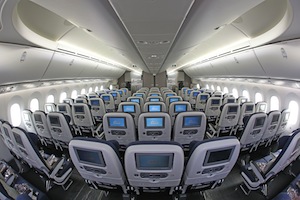 The A380’s system is the Thales i-5000, as also found on certain of the BA B777 and A321 fleet, while for the B787 the i-8000 architecture provided a better fit. To find out why the Thales system was selected, we asked Richard D’Cruze, BA’s IFE manager: “We had competitive bids from Panasonic and Thales. In terms of the customer offer they were very similar, but there were commercial factors – we had an existing relationship with Thales for a lot of the flight deck avionics, so we knew them and we got a good commercial deal. For the customer, the offers were similar – they both have terabyte servers at the front and they both have high-resolution monitors.”
The A380’s system is the Thales i-5000, as also found on certain of the BA B777 and A321 fleet, while for the B787 the i-8000 architecture provided a better fit. To find out why the Thales system was selected, we asked Richard D’Cruze, BA’s IFE manager: “We had competitive bids from Panasonic and Thales. In terms of the customer offer they were very similar, but there were commercial factors – we had an existing relationship with Thales for a lot of the flight deck avionics, so we knew them and we got a good commercial deal. For the customer, the offers were similar – they both have terabyte servers at the front and they both have high-resolution monitors.”
So why not one of the latest TopSeries models? “The TopSeries Avant wasn’t available at the time when we made the selection, but we have the option to move to Avant on later aircraft. Right now, the i-5000 and i-8000 offer a great customer experience, and all our A380s and B787-8s will be delivered with the systems, but we’re considering Avant as the system for the A350s and B787-10s,” explains D’Cruze.
So even the IFE ties in with the consistent passenger experience, although obviously with different screen sizes: 15.4in in first; 12.1in in business; 10.6in in premium economy; and 8.9in in economy. The first class display is smaller than that of some rivals, but following ergonomic trials it was decided that a smaller display closer to the seat was better than a larger screen set further back. “With the B787-9s, we are looking at mounting a 23in monitor further back, but it doesn’t fit with the logistics of the current cabin,” states D’Cruze.
On an unconnected note
One technology not on board either aircraft is wireless connectivity. “We’re still in the process of deciding our strategy on connectivity and wireless,” states BA’s IFE manager Richard D’Cruze. “We’ll be running a trial on one B747 this year, fitted with a Panasonic Global Communications Suite, which offers wi-fi, mobile phone connectivity, and media streaming so we can stream content to customers’ tablets, as well as live TV. We’ll run the trial for a year and, based on the strategy and based on the results, that will help guide our strategy of where we go with IFE and connectivity. It’s a big investment.”
BA has some experience in this field as it offers OnAir technology on its all-business London City to JFK route, but at present D’Cruze is still not convinced by the market. “At the moment, take-up of wi-fi is pretty low at around 4-5% on long-haul flights, so that’s a lot of weight to carry with not much usage. The jury is still out. Technology is evolving, but right now there isn’t a true home internet experience in the air – it’s a bit laggy and not as fast as on the ground.”
But could it find a home as BA’s short-haul IFE? “If you want to provide IFE on short-haul, wireless streaming is the way to do it as you don’t have to fit a heavy IFE system. The drawback is you can’t stream early-window Hollywood content, and that’s where the customer satisfaction is.”


